The Korn Kobblers formed in 1939 as an offshoot of another nonsense band, Freddie Fisher's Schnickelfritz Band, following a civil court case for who got to use the older name.
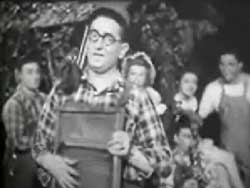 Some have insisted the Korn Kobblers & the Schnickelfritz Band are essentially the same, because it was at the time when the Freddie took the Schnickelfritz Band to Hollywood that Stan Fritts split off with some of the band members to head out East to radio success as the Korn Kobblers. Some have insisted the Korn Kobblers & the Schnickelfritz Band are essentially the same, because it was at the time when the Freddie took the Schnickelfritz Band to Hollywood that Stan Fritts split off with some of the band members to head out East to radio success as the Korn Kobblers.
However if you compare them you'll find the Schnickelfritz Band was funnier & a lot more talented. While the Korn Kobblers continuously remind the viewer of the worst junk ever seen on Hee Haw, the original Schnickelfritz Band is much closer to being a worthy precursor to Spike Jones.
The Korn Kobblers' first big gig with the new name was opening for Guy Lombardo at the 1940 World's Fair. Their faux-hillbilly act is only somewhat funny & unlike Spike Jones or the Hoosier Hotshots, there is little about the music per se that can be praised (unless for children), so they should be regarded primarily as lowbrow comedians.
They made several soundies under three minutes each for viewing in video jukeboxes, including Listen to the Mocking Bird (1941). A band with a name like that is bound to be silly, & here the band members are dressed up like a tribe of Elmer Fudds in the woods, with rifles or using their instruments as guns.
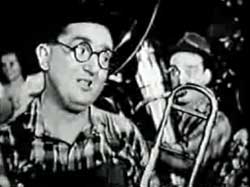 Their vocalist, playing a washboard, wears thick glasses & a plaid shirt. As he sings the lyrics, "I'm dreaming now of sweet Hally, sweet Hally," we're given a close-up of a guy in drag smoking a pipe. Their vocalist, playing a washboard, wears thick glasses & a plaid shirt. As he sings the lyrics, "I'm dreaming now of sweet Hally, sweet Hally," we're given a close-up of a guy in drag smoking a pipe.
Additional sight gangs follow. And while it's amusing to see a soundie crammed with sight gags, it's not much to listen to.
Crossdressing seems to be the height of the Korn Kobblers' sense of humor & they do it not only in Listen to the Mockingbird, but also in That's My Weakness Now (1941), singing in falsetto in a wedding gown.
The lyrics run "I never cared for eyes of blue/ But she's got eyes of blue/ And that's my weakness now." It's not as mediocre a song choice as the band usually makes, but the lead singer (& trombonist) lacks a voice for anything but comedy.
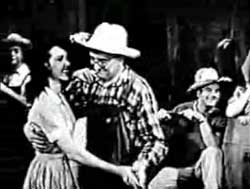 The brass instrumentation of trombone, trumpet & tuba is somewhat amusing, & there's a wonderful comic instrument made up of bicycle horns from which the operator squeezes considerable musicality. The Korn Kobblers really should've done their raucus music for cartoons. The brass instrumentation of trombone, trumpet & tuba is somewhat amusing, & there's a wonderful comic instrument made up of bicycle horns from which the operator squeezes considerable musicality. The Korn Kobblers really should've done their raucus music for cartoons.
I Want My Rib (1941) continues the Korn Kobblers' preference for mediocre novelty songs, the lyric regarding a guy who like Adam is missing one rib:
"They stole it from me when I was a kid you see/ I'll bet she's grown up now & pretty as can be."
The primary sight gag for this one, beyond everyone dressed as hillbillies, is one of the band members reaching blindly inside a pickle-barrel, wherein a hillbilly gal is hiding.
She pops up & slaps his face for diddling her. It wasn't funny once so of course they did it twice, not counting her friendlier pop-up when she greets the singer.
One of the Korn Kobbler's soundies, Listen to the Mockingbird, was included in the one-reel film made up from three soundies, Hillbilly Hits (1945), together with Hillbilly Hoosegow (1942) featuring Tom Enerson & His Mountaineers singing & yodeling while trying to break out of jail, & Florence Gill's There's a Hole in the Old Oaken Bucket (1942) backed by Redd Harper & the Fashionaires.
Florence performs her vocals exclusively in the voice of a clucking chicken. She voiced chickens in a number of animated cartoons & was the voice of the Disney character Clara Cluck. She actually kind of looks like Henrietta the old maid chicken who's always trying to trick Foghorn Leghorn into marriage.
Most of the hick & faux hillbilly soundies generally kind of suck, but Florence is a different animal, not really a hick but more of a lunatic, & funny as all get out, really putting her heart into her cluckery.
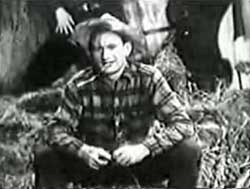 The first title card at the start of the jukebox soundie Turkey in the Straw (1942) promises "The Original Schnickelfritz Band with Freddie Fisher in" then to second straw for the soundie's titular song choice, i.e., Turkey in the Straw.
The first title card at the start of the jukebox soundie Turkey in the Straw (1942) promises "The Original Schnickelfritz Band with Freddie Fisher in" then to second straw for the soundie's titular song choice, i.e., Turkey in the Straw.
It opens on a set tricked out to look like a really run-down barn & hen-house with a fat trumpet player in bib overalls doing a pretty good rendition of the campy tune. The camera pans backward revealing the entire hillbilly band with instruments amindst piles of straw, & they join in the number.
As under-three-minute soundies go, the cinematography is a little more sophisticated than average & the set is a beaut.
The singer though funny has enough dignity to seem to be playing more of a farmer than hick. He begins the comic lyrics: "Oh I had a girl & she was good/ But one of her legs was made of wood/ Her hair was false & her teeth was too/ And there wasn't much for me to do." Harmonies are provided by George Rock, later part of Spike Jones & the City Slickers.
An instrumental bridge with a tiny whistle & a jug is really clever. At the second bridging instrumental Freddie swaps the whistle for a sax & while making ugly faces gets the sax stuck in his cheek.
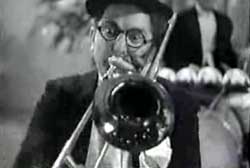 While I found the Korn Kobblers barely worth tracking down, the Schnickelfritz Band & especially its leader -- the multitalented Iowan Freddie Fisher -- are a pure joy. With numbers in their repertoir like Tiger Rag, Red Hot Mama, & Wabash Blues, they had a greater "Iowa Hick" authenticity, a sufficient jazz content to be fun music, & an overall musicality which for all the clowning around could really keep the toes tapping. While I found the Korn Kobblers barely worth tracking down, the Schnickelfritz Band & especially its leader -- the multitalented Iowan Freddie Fisher -- are a pure joy. With numbers in their repertoir like Tiger Rag, Red Hot Mama, & Wabash Blues, they had a greater "Iowa Hick" authenticity, a sufficient jazz content to be fun music, & an overall musicality which for all the clowning around could really keep the toes tapping.
The Schnicklefritz Band isn't doing the hillbillies routine for "Tiger Rag" which they performed in Gold Diggers in Paris; aka, The Gay Imposters (1938).
Rather, they are dressed up like sophisticated guys, except they start off with some of them playing their instruments laying on their backs (the drummer drumming the underside of his snare drum).
Stan Fritz is still in the band playing trombone -- he'd soon leave to start up the inferior Korn Kobblers. Also still on board is trumpeter George Rock who'd later join Spike Jones' band. Versatile Freddie is on sax, then clarinet.
Watching the crazy performance of the title song is Rudy Vallee & a pal. In real life, Rudy's agent pretty much discovered Freddie Fisher & his group in the midwest & put them in this film. But since the film was already completed, the clip of the Schnicklefritz Band is a free-standing afterthought that got spliced in just before the film's release.
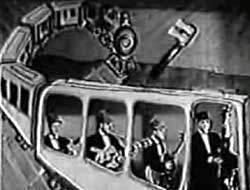 Roy Lanham's little band The Whippoorwills are shown on quite an amazing set for Get Get On Board Li'l Chillun (1952).
Roy Lanham's little band The Whippoorwills are shown on quite an amazing set for Get Get On Board Li'l Chillun (1952).
The set's designed to make it look like the band is on a train, though they're behind a painted cut-out.
Lanham was a talented western swing guitarist with the Sons of the Pioneers, but his own group tended to be less interesting, thoug it varies song to song.
The female vocalist was Georgia Brown who liked being billed as "Sweet Georgia Brown." Georgia strolls in front of the set then the band disembarks the train one by one, to the slow guitar beat.
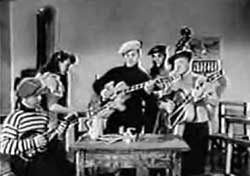 They then sing the country gospel about "the gospel train's a-comin'." It's a sweet little number that strides between outright country performance, & boogie woogie. They then sing the country gospel about "the gospel train's a-comin'." It's a sweet little number that strides between outright country performance, & boogie woogie.
From Get On Board Li'l Chillun one would expect the Whippoorwills were a country swing band foremost. But their sound was diverse, not always a good thing.
Another Snader telescription Hard Life Blues (1952) makes them look like a first-rate bluesy swing group with scarsely a whiff of country, thanks in great part to Roy's guitar work; he could do anything.
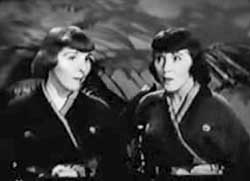 Lead vocalist Georgia Brown does the number pretty well, though the arrangement is so uneven it's ultimately unsatisfying. Lead vocalist Georgia Brown does the number pretty well, though the arrangement is so uneven it's ultimately unsatisfying.
It starts very bluesy then goes to the up-beat dance number. "Everytime I travel, blues are on my mind/ Had a lot of trouble, blues of every kind."
The Whipoorwills back up the Ewing Sisters in the telescription So Long Oolong (1952), a mite offensive because of the phonied up Asian stereotyping that's worked into the novelty number.
With goofball lyrics like "So long Oolong how long you gonna be gone" it can be taken as a fun piece of camp. Lyrics that manage to stick in Edgar Allan Poe's name just because it rhymes easily certainly doesn't want to be taken seriously.
copyright © by Paghat the Ratgirl
|

 Some have insisted the Korn Kobblers & the Schnickelfritz Band are essentially the same, because it was at the time when the Freddie took the Schnickelfritz Band to Hollywood that Stan Fritts split off with some of the band members to head out East to radio success as the Korn Kobblers.
Some have insisted the Korn Kobblers & the Schnickelfritz Band are essentially the same, because it was at the time when the Freddie took the Schnickelfritz Band to Hollywood that Stan Fritts split off with some of the band members to head out East to radio success as the Korn Kobblers. Their vocalist, playing a washboard, wears thick glasses & a plaid shirt. As he sings the lyrics, "I'm dreaming now of sweet Hally, sweet Hally," we're given a close-up of a guy in drag smoking a pipe.
Their vocalist, playing a washboard, wears thick glasses & a plaid shirt. As he sings the lyrics, "I'm dreaming now of sweet Hally, sweet Hally," we're given a close-up of a guy in drag smoking a pipe. The brass instrumentation of trombone, trumpet & tuba is somewhat amusing, & there's a wonderful comic instrument made up of bicycle horns from which the operator squeezes considerable musicality. The Korn Kobblers really should've done their raucus music for cartoons.
The brass instrumentation of trombone, trumpet & tuba is somewhat amusing, & there's a wonderful comic instrument made up of bicycle horns from which the operator squeezes considerable musicality. The Korn Kobblers really should've done their raucus music for cartoons.
 While I found the Korn Kobblers barely worth tracking down, the Schnickelfritz Band & especially its leader -- the multitalented Iowan Freddie Fisher -- are a pure joy. With numbers in their repertoir like Tiger Rag, Red Hot Mama, & Wabash Blues, they had a greater "Iowa Hick" authenticity, a sufficient jazz content to be fun music, & an overall musicality which for all the clowning around could really keep the toes tapping.
While I found the Korn Kobblers barely worth tracking down, the Schnickelfritz Band & especially its leader -- the multitalented Iowan Freddie Fisher -- are a pure joy. With numbers in their repertoir like Tiger Rag, Red Hot Mama, & Wabash Blues, they had a greater "Iowa Hick" authenticity, a sufficient jazz content to be fun music, & an overall musicality which for all the clowning around could really keep the toes tapping.
 They then sing the country gospel about "the gospel train's a-comin'." It's a sweet little number that strides between outright country performance, & boogie woogie.
They then sing the country gospel about "the gospel train's a-comin'." It's a sweet little number that strides between outright country performance, & boogie woogie. Lead vocalist Georgia Brown does the number pretty well, though the arrangement is so uneven it's ultimately unsatisfying.
Lead vocalist Georgia Brown does the number pretty well, though the arrangement is so uneven it's ultimately unsatisfying.